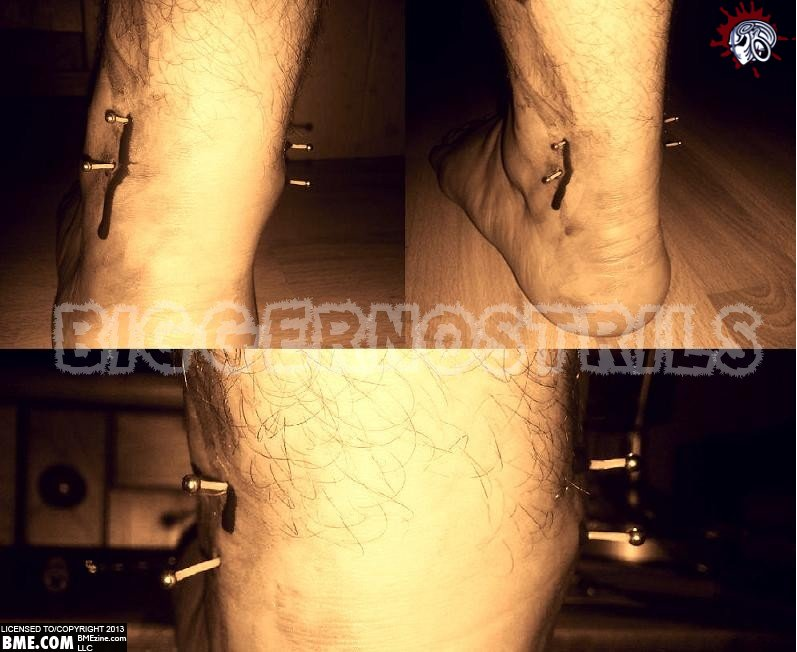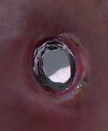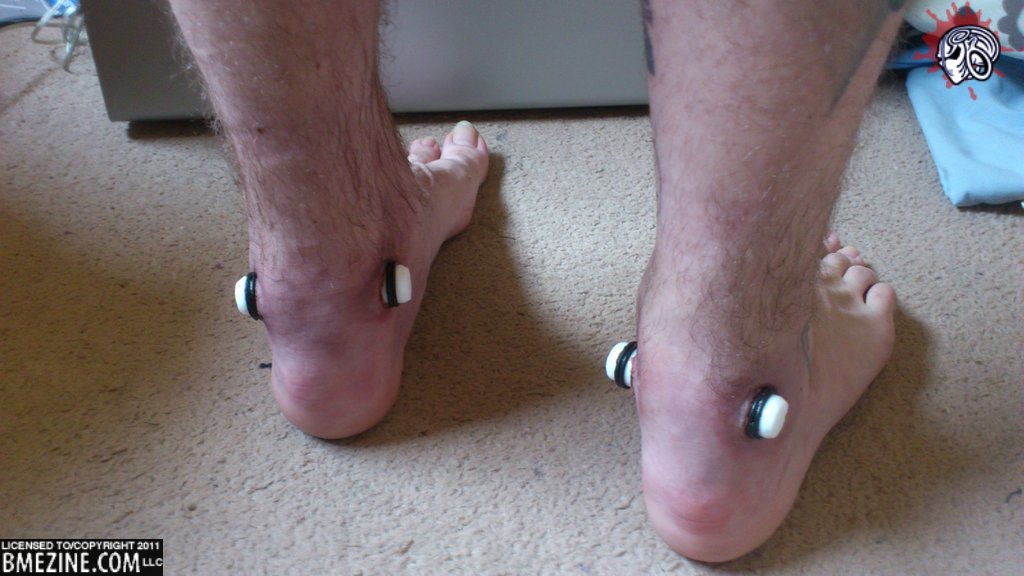I’ve posted about Daniel Rutt’s amazing piercings elsewhere (and Rob featured them ages ago in a “guess what” post), but I thought ModBlog deserved me taking the time to talk to him about them in detail. The story begins just over two years ago when, a week before Christmas 2010, Daniel had Patrick Kielty (of Body Alter in Worksop, England) do the pair of deep achilles piercings using 1.6mm (14ga) PTFE flexible rods, prescribing the normal simple aftercare of using salt water solution to keep them clean.
Before I talk more about Daniel’s life after leaving the studio, I want to quickly share what Patrick told me about doing the piercing. First he did lots of anatomical study, which lead him to decide that if when he felt for the “sweet spot” he would only continue with the piercing if the tissue was minimal an he was quite certain he wasn’t going to be hitting anything he shouldn’t. Luckily in Dan’s case he could “practically feel [his] thumb and finger touch”, so they went ahead with the calculated risk of skewering him with a needle running between the achilles tendon and the bones of his leg and ankle. From the piercer’s point of view, Patrick described it as something akin to a scaled up handweb, and quite soft to get through.
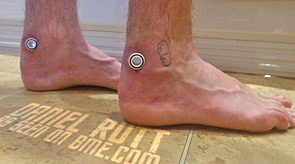

As you can see, it’s a lot bigger than 14ga now, because every few months he’s stretched it up (much to Patrick’s surprise incidentally). Initially he did this by using different sized PTFE rods, which he found extremely painful due to the rods jumping up in size 2mm at a time — squeezing them through the piercings was difficult and uncomfortable. Once Daniel reached 6mm (about 2ga), he gave up on this method and switched to packing the piercing with a whole bunch of small 1mm (18ga) PTFE rods. Every time he felt ready to stretch he would push another small rod into the middle (or sometimes two, but never more). It was still slightly uncomfortable, but overall the method worked well and in any case was a big improvement over the larger steps in his initial method. Because of the smaller increases, he spaced them just under a month apart.
I asked Daniel if he’d do it the same way if he were to do it again, and he said that in hindsight it might have been better to use the tape method — that is, using tape wrapped around a PTFE rod core to very gradually increase the size — with the hope that it would be even less strenuous. He also advises anyone who’s considering this piercing — who really, really wants it — to not stretch too quickly, and not to goo too big with it.
Daniel got his achilles piercings up to 16mm (5/8″), but felt that he’d hit a limit and downsized to 15mm. He explains, “I can’t ever see this kind of mod going any bigger than 15mm without causing serious risk, involving lack or loss of walking and movement.”
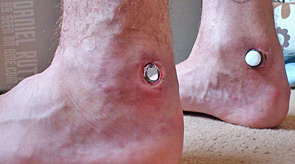
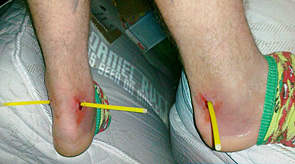
Another problem with this piercing — and deep piercings in general — is that they take forever to heal, long enough that it’s easy to believe that they never truly heal. Until someone figures out a surgical way of doing them that’s akin to a stitched transscrotal (and I’m not sure this could be safely done outside of a proper operating room), this is a piercing that one can expect to look red, irritated, and swollen for several years! And by “several years”, I may mean over a decade — you might recall Mr. Tetanus’s, whose are still a “tolerated wound” after twelve years. Daniel’s are admittedly a little scary looking, especially to those not particularly friendly or comfortable with piercings in general, as Daniel learned one trippy evening that saw him brought into the hospital in a… shall we say… somewhat “mentally incapacitated” state. Upon seeing it, the doctor removed the jewelry, and, unable to stop him at the time, Daniel had to wait until being discharged to put it back in — since that experience he’s avoided showing it to doctors!
As I said, Daniel’s are over two years old now and are still healing — hopefully the downsizing will help them settle down. This is a piercing that takes real commitment to keep, and Daniel warns that he’s “had quite a lot of complications with it, like pain when I walk, and my legs aching when I’m on my feet for too long, although since reducing to 15mm it seems improved.” The more serious disabilities brought on by the piercing seem to be most pronounced after stretching, which sometimes reduced Daniel to limping, but with the downsize he says that he feels “more agile and less fragile”.
Daniel is currently waiting for some new winged jewelry — what a great idea by the way — so hopefully I’ll post a follow-up with those. The images in this post are from various stages in the piercings’ life. I really want to emphasize — and I hope that some of the troubles Daniel describes help underscore this — that this is not a piercing that most people should attempt. It’s got a high potential of crippling you, and requires constant attention and a good understanding and awareness of the body. In addition to his achilles piercings, Daniel has had multiple uvula piercings and wears subclavicals, so he’s definitely no beginner.
